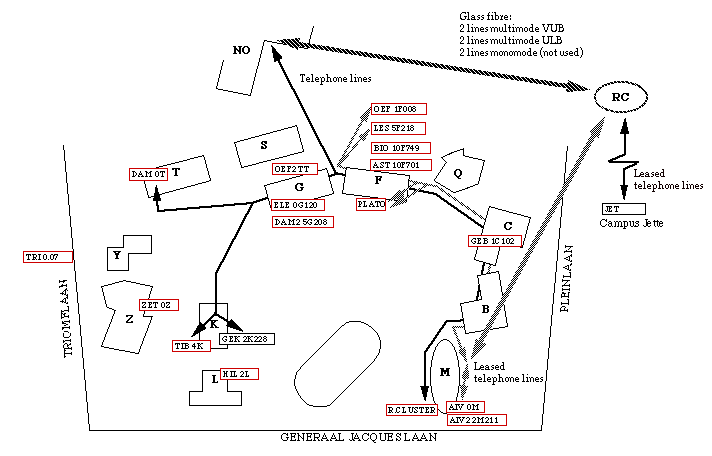In 1976 the Central Computer Centre (founded in 1970, at that time mainly fulfilling batch jobs) started developing its own network. This network with a star topology had as main goal to offer access to the central CDC 6500 and CDC 6600 machines.
The nodes in this network were microprocessor driven multiplexers, named ‘clusters’. Using local telephone cabling and RTT-lines, up to 500 terminals (in 1982) and printers were physically connected by the network. A front end computer (Modcomp mini computer) managed the communication between the mainframes and the network. The clusters as well as the communication protocol were developed by the Computer Centre.

Due to the decentralization of computer resources, this Computer Centre conceptually no longer matched the demand in the eighties. On one hand several mini computers appeared in different services, on the other hand there was the explosive increase in personal computer usage. Users who until then only had access to the central machines, were now able to perform part of their work (like secretarial work, exercise sessions, etc.) on local machines.
Stimulated by Prof. Dr. Ir. J. Tiberghien and thanks to the effort of Prof. Dr. Ir. M. Goossens, the VUB decided to build VUBnet, a network enabling communication between local machines. Nevertheless the need for flexible access to the mainframes kept existing. In 1988, the central backbone of this new network was expanded to incorporate the powerful ‘number crunchers’ of the Central Computer Centre. In the beginning of 1989, the two CDC machines (Cyber 180/815 en 180/855) got the companionship of the first super computer in Belgium: a Cray X-MP/14!
In 1989, the management and further development of VUBnet became the responsibility of the Central Computer Centre, with as primary goal optimal support for the VUB community.
In 1991, the Cyber 180/815 and 180/855 were replaced by four EP/IX servers: two interactive CD4360-300 servers, a CD4360-300 file server and a CD4680-101 NIC server (Numerical Intensive Computer). At that time the old CC-net was also completely run down.
By the end of 1991, the Cray X-MP/14 was replaced by a Cray Y-MP2E/116. In 1995, the Cray Y-MP was replaced by a J916 plus an SGI Challenge was also acquired. In 1997, the EP/IX servers were shut down for good.
The VUBnet network itself kept on growing with the ever increasing number of machines connected (2900 in April 1998). The FDDI backbone structure evolved from a ring to a star topology, fast L2 switches were introduced and the bandwidth of the links to Jette and Rode improved dramatically.
